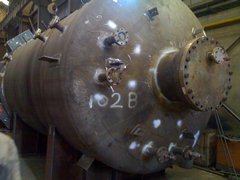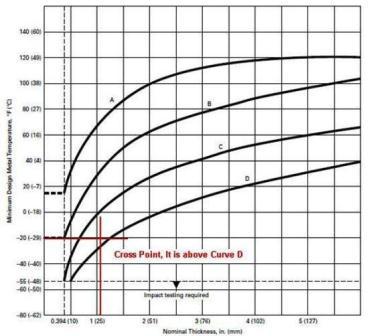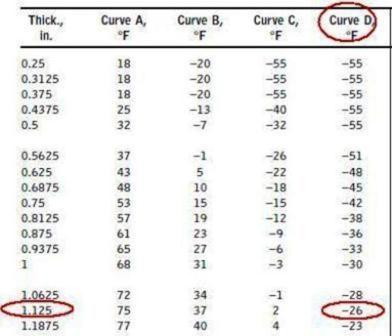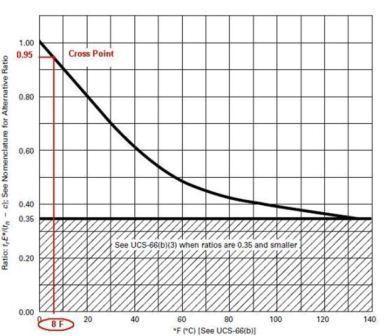Watch our Most Recent Videos | Visit us on LinkedIn | Visit us on YouTube
ASME Impact Test Requirement
The ASME Impact Test Requirement I4I Academy LLC article provides you with information about impact test requirements in pressure vessel design and construction.
Let's say, you have a pressure vessel under design, process and construction has not started yet.
Based on the ASME impact test requirement, you need to make assessment to see that either your pressure vessel is exempted from impact testing, or you need to carry out the test.
There are 4 steps for impact test exemption assessment. You need to know these steps. You might be exempted in the first, second or third steps and might not be exempted even in step 4.
So if you are in step 4 and you have not exempted, then you need to carry out the test. I will explain the process for exemption in this article.
I4I Academy offers a range of courses covering impact testing requirements, with our API 510 online training course featuring a dedicated section on ASME Section VIII Div.1 that addresses this topic. This course includes resources like flashcards, video sessions, and practice questions to aid in understanding impact testing. Moreover, the API 510 course delves into the issue of brittle fracture susceptibility in in-service pressure vessels. This aspect is also covered in the API 571 Online Corrosion and Material course, which focuses on damage mechanisms in the refining industry. Both courses provide valuable resources, including flashcards, video sessions, and practice questions. Furthermore, the API Source Inspector course includes a dedicated session on impact testing. This topic also is covred in ASME Training course. The ASME B31.3 has similar requirements for process piping and is covered in the I4I Academy API 570 piping inspector online course.
ASME Impact Test Requirement Basic Concept
You may know carbon steels and low alloy steels exhibit a drastic change in their room temperature ductility at sub-zero service temperatures. Different types of materials exhibit different types of transition behavior.
We can see there is a sudden, phenomenal drop in their notch-toughness properties below the "transition" range of temperature, which should be a matter of concern for us.
Body centered cubic or Ferritic alloys exhibit a significant transition in behavior when impact tested over a range of temperatures. Above transition temperature range, impact specimens fracture in a "ductile" manner, absorbing relatively large amounts of energy.

At lower temperatures, i.e. below the transition temperature range, the impact test specimens are found to fracture in a brittle (cleavage) manner, absorbing less energy.
And within the transition temperature range, the fracture is a mixture of ductile and brittle nature.
A material would be invulnerable to a sudden drop in notch-toughness at the lowest specified service (or design) temperature, if it is proved by conducting Charpy V-notch Impact tests on representative test samples, at reference (the lowest service) temperature.
Grain refined carbon steel forgings and wrought materials (thoroughly worked and normalized) generally exhibit good notch toughness.
The ASME Training Course is 5 days video training course and available online and the student that successfully pass the exam, receive I4I academy certificate with 40 hours training credit.
ASME Code Section VIII Div 1 Exemption Rules for ASME Impact Test Requirement:
There are specific rules in ASME Code for exemption from ASME Impact Test Requirement. This test is very expensive, so pressure vessel manufacturers are trying to be exempted for this costly test.
You need to follow the following clauses to make exemption assessment for ASME impact test requirement:
UG-20(f) →→→UCS-66(a) →→→ UCS-66(b) →→→UCS-68(c)
First you have to keep your pressure vessel design data available and then refer to UG-20 (f). If you are exempted from this clause, you do not need proceed further.
But if you are not exempted by UG-20 (f), you have to proceed to UCS-66(a), but again if you are exempted, there is no need for more assessment.
But if not, you have to proceed to UCS-66(b). If you are exempted now, there is no need for more assessment; otherwise, you have to proceed to UCS-68(c), and again if you are still not exempted, you have to carry out impact testing.
For some cases, You might be exempted from the ASME impact test requirement in the first stage in UG-20 (f). In others, You might be exempted in UCS-66(a) or UCS-66(b) or UCS-68(c). If you are not exempted, you must prepare yourself for doing this costly test.
This test would be more costly out of the US because of Laboratory Accreditation requirements. Also, there are fewer accredited labs in Europe and the Middle East, and their price is high as well.
UG-20(f)
We will start with UG-20(f) for the ASME impact test requirement. If your MOC (Material of Construction) is categorized in P-No. 1 or 2 (Refer to ASME Code Section IX for P-No Definition) and your MOC thickness has the limited value defined in this clause, then you might be exempted from impact testing.
But you need to refer to Fig UCS-66 in ASME Code Section VIII Div 1 and see in which A, B, C or D curves your MOC is listed. All ASME carbon steel and low alloy steel material is distributed in these 4 groups (Curves) of materials.
You need to know that the materials listed in curve D have the best toughness property, better than the materials listed in curve C. Similarly materials listed in curve C have better toughness properties compared to materials listed in curve B and materials listed in Curve B have better toughness than materials listed in Curve A .
See Following Fig UCS-66(a):

When you determine your MOC curve, then you have to review UG-20(f) and look for the possibility of exemption from the ASME impact test requirement. There are some other conditions in this clause, which you should consider for exemption.
For instance, the vessel should be hydrostatically tested after completion, and the thermal and mechanical loading can not be a design controlling factor.
For example, if your MOC is a normalized SA 516 Gr.70 with 0.75 inch thickness you will be exempted from ASME impact test requirement.
Your thickness, in this example, is 0.75 of an inch, and is listed in curve D which is up to 1 inch, you are exempted by this clause. Of course, you will be carry out hydro-static test and ensure that the mentioned loadings are not a design controlling factor in your considered pressure vessel.
UCS-66(a)
So assume that in the above example, your MOC thickness is 1.125 inch instead of 1 inch, you will not be exempted by UG-20(f) and you have to refer to UCS-66(a);
But for assessment, based on this clause, you need to know your pressure vessel MDMT (Minimum Design Metal Temperature). Assume that is -20 degree F, so you should now go to Fig. UCS-66 and locate 1.125 inch in the horizontal axis and draw a vertical line.
In a similar way, locate -20 degree F in the vertical axes and draw a horizontal line. These two lines will cross each other.
See above Figure, the lines are identified in red.
If the cross point falls above the curve D (because your MOC is listed in curve D) you are exempted. Otherwise you are not, but for the current example, you are above the curve D so you are exempted from impact testing.
To simplify your assessment for the ASME impact test requirement, the Fig-66 has been converted to the table(table UCS-66). For any MOC with specific thickness you can go to this table and see what is the minimum permissible temperature without impact testing.
See following UCS-66(a) Table:

In the above example (normalized SA 516 Gr.70, Curve D, 1.125 inch thickness), the minimum permissible temperature without impact test is -26 degree F. This means that, if in the above example your MDMT changes from -20 degree F to -27 degree F, then you cannot be exempted from the ASME impact test requirement by UCS-66(a), and you have to proceed to UCS-66(b)
UCS-66(b)
Let us explain this clause with the above example. Your MDMT from above is -27 degree F, nominal thickness is 1.125 inch, normalized SA 516 Gr.70 listed in curve D and you are not exempted by UCS-66(a)
So you are here to continue your assessment to find a chance for exemption. You have to refer to Fig UCS-66.1 and calculate the following formula:
Ratio= tr E / (tn –c)
tr is the required design thickness for all applicable loading. We assume for the above example that is 0.95 inch. E is your joint efficiency, and we assume for this vessel it is 1. This means your vessel is RT2, tn is your nominal thinness, which in the example from above it is 1.125 inches, and C is corrosion allowance, and we assume it is 0.125 inches; so let calculate:
Ratio = 0.95x1/(1.125 – 0.125) Ratio= 0.95
See following Fig UCS-66(b):

Then go to the Figure UCS-66(b) and in the vertical axes locate Ratio and draw a horizontal line. Then locate the cross point with the graph and draw a vertical line to cross the horizontal axis.
You will be able to reach a value of 8 in the horizontal axes. This 8, is your 8 degree F bonus from table UCS-66, which you can reduce by 8 degrees F minimum permissible temperature in table without impact testing.
In the above example, your MDMT is -27 degree F, and in the UCS 66 table, the minimum permissible temperature without impact testing designated -26 degree F. So with this clause you can reduce it to -36 degree F(-26 -8 = -34). Your MDMT is -27 degree F, so you are exempted from impact testing with this clause.
UCS-68(c)
Let us change one variable in the above example. Let's assume you need to have -45 degree F for your MDMT. Other variable are the same; it means normalized SA 516 Gr.70 listed in curve D, thickness 1.125, so you can see you are not exempted by UCS-66(b);
This is because the minimum permissible temperature is -36 degree F, but your MDMT is -45 degree F, so UCS-68(c) might be helpful.
It says that if post weld heat treatment is not a code requirement and your P-No is 1 and you carry out post weld heat treatment, a 30 degree F bonus will be granted to you to reduce the minimum permissible temperature in table UCS-66.
So when post weld heat treatment is code requirement?
It is code requirement when your service is lethal and when your thickness for P-No. 1 is greater than 1.5 inch;
So, for our example, our service is not lethal and our P-No. is 1 and thickness is 1.125 and it is less than 1.5 inch: therefore, post weld heat treatment is not code requirement.
It means if you carry out post heat treatment, a 30 degree F bonus will be granted by this clause. For this example our minimum permissible temperature would be -36-30=-66 degree F, and your MDMT is -45 degree F, so you are exempted from impact testing.
Now the worst case: in the above, assume you need to have -70 degree F for your MDMT; you can see with this new condition you cannot be exempted even by UCS-68(c) and you have to carry out impact testing.
Related Articles
Pressure Vessel Definition, Pressure Vessel Certification, Pressure Vessel Heads, Pressure Vessel Handbook, Spherical Pressure Vessel, Pressure Vessel Plate Material, ASME Pressure Vessel Joint Efficiencies, Pressure Vessel RT Test , Vessel Pressure Testing ,Third Party Inspection for Pressure Vessel, Inspection and Test Plan for Pressure Vessel, ASME Code Section 8
Free newsletter!
Sign up to receive my monthly newsletter covering all the latest courses and updates.




New! Comments
Have your say about what you just read! Leave me a comment in the box below.